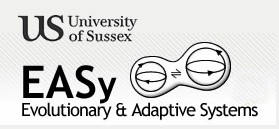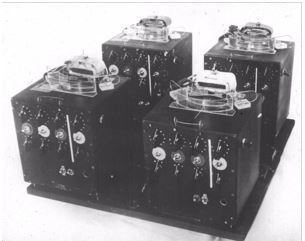
I developed an interest in machine intelligence. So when I retired I took a Masters degree at Sussex University: EASy ( Evolutionary and Adaptive Systems ) which in the university’s words is concerned with the interfaces between the biological and computational sciences, particularly with reference to furthering the understanding of brains and minds . My particular interest was (and still is ) in artificial neural networks and genetic algorithms. . I am indebted to the course convener , Inman Harvey , for pointing out that the word ‘artificial’ has two flavours of meaning: on the one hand a product of artifice , i.e. man-made or on the other hand – fake. As for the concept of ‘intelligence’ , well that’s another slippery fish.
For the computerised variety of intelligence , the term machine intelligence was used by Donald Michie and is more accurate. The ‘artificial’ variety should really be artificial something – like Artificial Human Intelligence or Artificial Bee Intelligence. Anyway enough of that.
I include the abstracts from three of my papers from the course.
1 – Extensions to the neural net solution of The Dowry or Secretary problem
In this paper I revisit a continuous time recurrent neural network (CTRNN) solution to the problem known as the Dowry or Secretary problem, a problem that would seem to need a mathematical analytic solution . I investigate the network solution with a view to seeing if in the longer term its application could be extended into other real world problems by removing some of the constraints in the original experiment. Specifically I investigate i) adding noise to the input values and ii) drawing the input values from a pseudo-Gaussian rather than a uniform distribution. In the paper I present my results and I show that the by employing a more relaxed but biologically plausible evaluation method the CTRNN solution is resilient to both the addition of noise to the input and the use of a pseudo-Gaussian rather than a uniform distribution.
Five datasets were used in the experiment, from both a uniform distribution with no noise and three different amounts of noise, and the fifth from a pseudo-Gaussian distribution (devised specifically for this experiment) and all five were presented to two solution methods; the analytic solution and a network solution . Using two biologically plausible evaluation methods, Mean Relative Ranking (MRR) and to a slightly lesser extent Mean Relative Value (MRV) the network solution was shown to be comparable to the analytic solution. The results were consistent with the results obtained in the two previous experiments – Tuci, Harvey and Todd (2002), and Manicka and Harvey (2008). This provides cause for optimism that using a CTRNN could be embedded in a more realistic problem which involved making a choice from a sequence of options whose distribution is more realistically normal and noisy. Such a problem could be, for instance, the problem of an agent selecting from a sequence of foraging sites and the investigation of such a problem could well be the next step in extending the approach of this paper.
2 – An examination of an aspect of Ashby’s homeostat

This paper is concerned with concepts of homeostasis and ultrastability as described in Ashby(1960). It proposes that demonstrations of these phenomena both by Ashby and subsequent researchers have overlooked a crucial test – that is that after a disturbance has triggered the ultrastabilising mechanism the system should then be stable when that same trigger is reapplied. But both Ashby’s original equipment and the randomising methods used by subsequent researchers make demonstrating this aspect difficult or impossible. I describe Ashby’s concepts of stability, homeostasis and ultrastability and his experimental homeostat. I discuss briefly some Ashbian-inspired work by other researchers and I present a set of experiments
The experiments illustrate several points. First, using preset random weights and biases (in the manner of Ashby’s homeostat resistors) , as opposed to other researchers’ dynamic reconfiguration of weights in their simulations, adversely affected the performance of a single unit by only 6% as measured by the number of reconfigurations needed to re-establish stability. This indicates that it is feasible experimentally to use preset weights as Ashby did, rather than the dynamically generated random values used in subsequent simulations. This method has the advantage that if the external inputs are implemented as time series arrays, the whole system is then deterministic and that allows for controlled experiments. Second, the ability to set up a controlled experiment allowed me to demonstrate a’ true test‘ confirmation of Ashby’s level 2 stability which I feel was missing from both the work of Ashby and subsequent researchers. Di Paolo(2000) for instance impressively demonstrates the power of Ashbian-inspired adaptation but the nature of the experiment means that it is not possible to demonstrate how the system changes to as to be stable under the conditions which triggered re-configuration (and indeed the experiment was not designed to show this). To do that requires a much simpler controlled experiment as presented in this paper. Third, I note (and Williams(2006) notes) that , perhaps obviously, not all homeostat configurations will exhibit ultrastability in all circumstances. This requires some normative selection at a higher level. For example in my case to set up one of the experiments needed a degree of manual searching to show the desired effect. In other words Ashby’s principle is not restricted to two levels. In the homeostat, two-level ultrastability would derive from the selection of sets of resistor values from a preset pool, but three-level ultrastability would require rewiring by adding to or changing the resistor sets. The parallel in the natural world would be two-level ultrastability resulting from the recombination or activation of existing genes whereas three-level ultrastability would require mutation of existing genes or the addition of new genes.
3 – The performance of a minimal agent, controlled by a CTRNN, in a multi-objective task involving sequential choices
This paper derives , to a degree, from the extension to the Dowry problem described above, and demonstrates how a minimal agent can be evolved to perform well in a multi-objective task involving a sequence of choices. The agent was a simulated robot, with a single external sensory input, an internal sensor and a single motor output, linked by a 3-neuron controller which was evolved using a genetic algorithm. The environment was inspired by the problem of foraging during migration and consists of a route populated with a series of refueling stations and the task involves how much fuel to take up so as to complete the route in the minimum time. Furthermore, when evolved over a small number of routes, the agent is shown to be able to generalise and adapt to a much greater number of routes. In addition I show that this minimal agent is resilient to variations in the fuel station spacing and to the concentration of fuel, and can adapt to both types of variation. In the latter case the agent preferred to refuel at the higher concentration stations, which is the optimal strategy.
The project sets out to investigate the capability of a minimal 3-node CTRNN to evolve to solve a multi-objective problem involving a sequence of decisions with one of its inputs having discrete values. Four experiments based on a simulated robot agent, controlled by a fully connected CTRNN and evolved by the microbial genetic algorithm showed that it could do so. Further, it exhibited the capabilities to generalise beyond its evolutionary experience and could also evolve to be resilient to variations in the otherwise regularities of the environment. One failure was the inability of the agent to ‘look ahead’ and adjust its fuel uptake at the end of each route (perhaps unsurprising , given that there were only 3 neurons). Certain directions of future research suggest themselves: i) could the agent be evolved to minimise the fuel left at the destination and further improve its index of performance?, ii) in that case could the objective be added as an explicit third element in a three-part multi-objective problem?, iii) could the agent be evolved to adapt to systematic changes in station spacing ?. On a different tack it would be interesting to devise some graphical or other technique to tease out the tantalisingly simple-looking relationships between certain entities that emereged. It might then be possible to reverse engineer a few ‘simple behavioural rules’ (Erni,Liecht and Bruderer(2002), in Section 2.1 ) thereby addressing the reservations expressed by Shanahan (2000) (Section 1.1) that ‘having an overtly logic-based deliberative component, seems to offer researchers a direct path to robots with high-level cognitive skills’ by showing an equivalence between a computational and dynamical systems solution.

